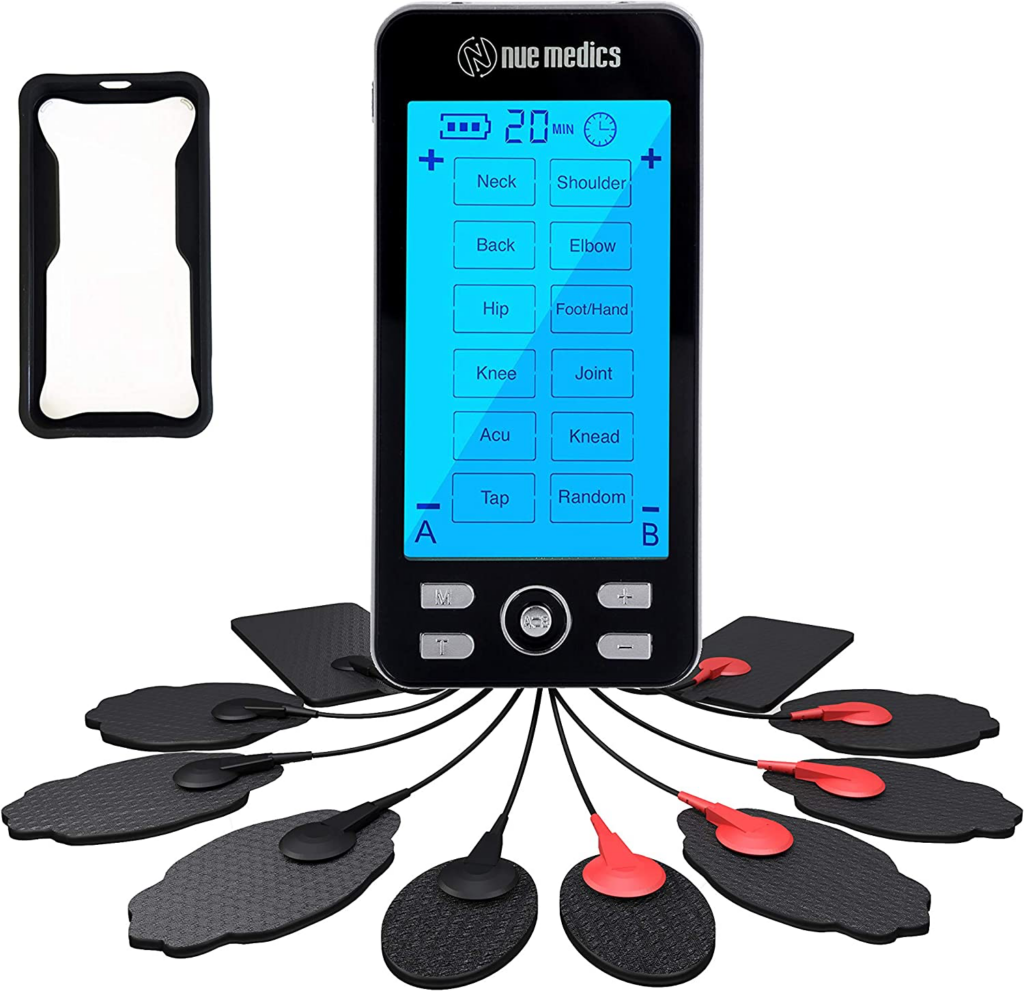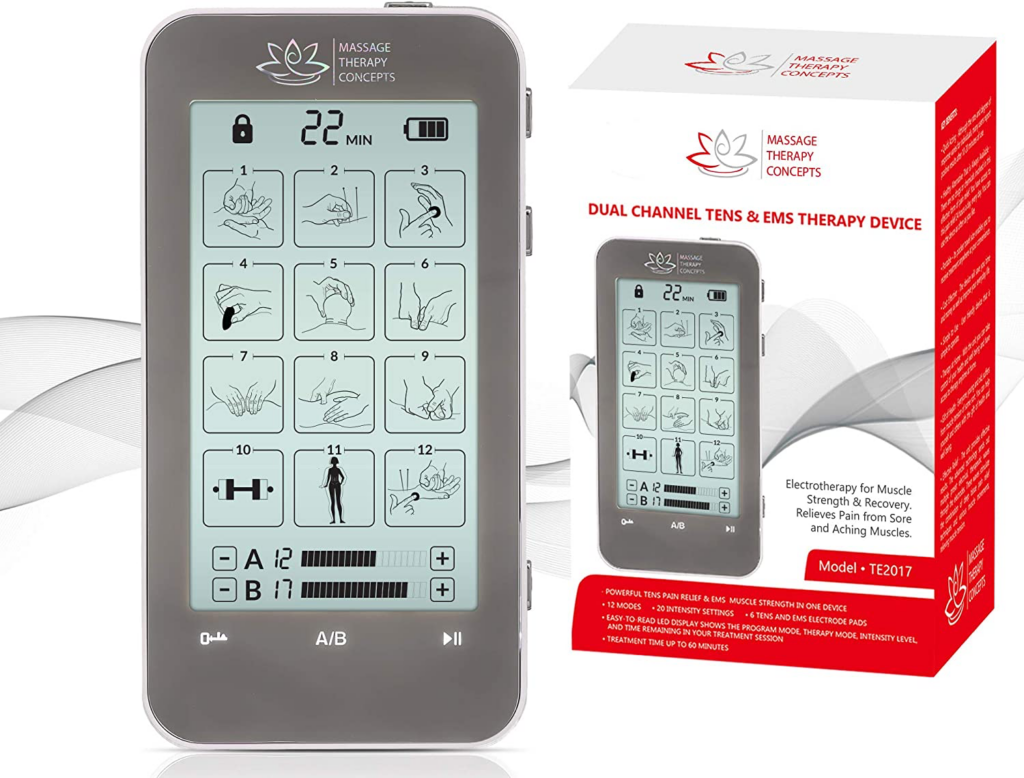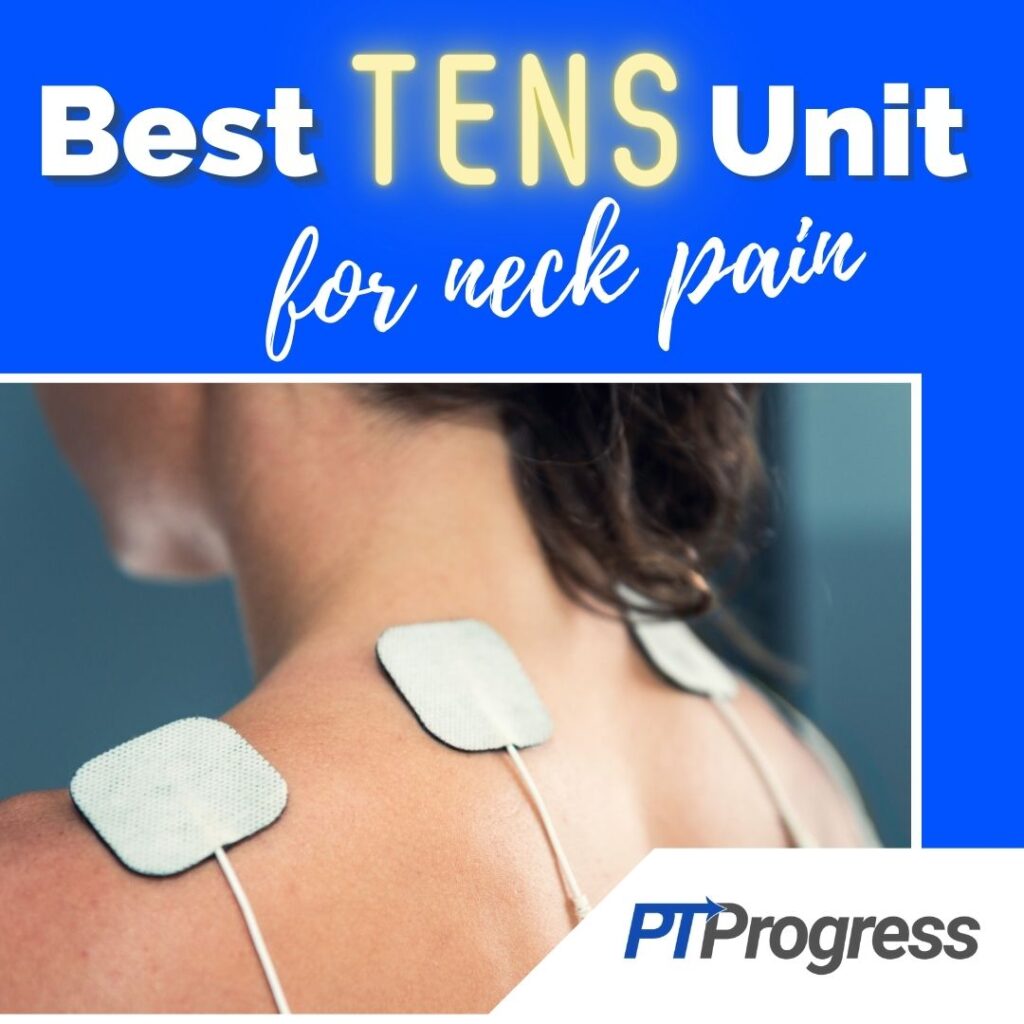
When you have neck pain, it’s hard to focus on anything else. There are many avenues for managing pain, but in this article I’ll focus on one gadget-operated method we use in the clinic. Keep reading for an overview of TENS therapy and the best TENS unit for neck pain.
Neck Pain Intro
Neck pain is a common symptom that can occur for a variety of reasons. For example, you may experience neck pain suddenly after a car accident in the form of whiplash. You may even wake up with acute neck pain and stiffness simply from sleeping wrong. Neck pain can rear its ugly head after a prolonged period of poor posture, or it may develop from degenerative osteoarthritis.
And besides the shooting pain and restricted range of motion, neck pain can also cause proximal pain, such as migraine headaches and trigger points in the back and shoulders. Whatever the nature of your neck pain, one pain-relief option you shouldn’t overlook is TENS.
TENS therapy overview
Transcutaneous electrical nerve stimulation, or TENS, is a pain management therapy wherein a battery-operated device transmits an alternating current via cutaneous electrodes. You simply place adhesive pads near the painful area on your skin, attach the pads with lead line to the device, and use the device to send wavelengths of therapeutic electrical stimulation.
It may smell of snake oil, but the science behind TENS is legitimate and well-documented. When applied to the skin, electrical stimulation causes vasodilation or an increase in blood flow, which naturally helps relieve pain. TENS signals also interfere with pain receptors, helping the muscles relax and giving you a break from the pain. In response to the electrical pulses, your body will release endorphins, natural feel-good hormones that outlast the therapy.
For these reasons and more, health professionals such as physical therapists use TENS to help manage their patients’ pain. Compared to other methods of pain relief, TENS is safer, non-addicting, and non-invasive. It’s also relatively inexpensive and—fortunately for DIY consumers—available for home use.
Contraindications for TENS
Although TENS is easy to use, affordable, and effective, it’s not for everyone. Do not attempt TENS without consulting your doctor if you have any of the following:
- An implanted medical device such as a pacemaker
- A recent history of cancer
- Epilepsy
- Pregnancy
How to Use TENS for Neck Pain
If you’ve ever used a TENS unit for shoulder pain, then you’ve got a headstart on using TENS for neck pain. The process is very similar.
Most TENS units consist of a set of electrodes with sticky pads, lead wires (unless it’s a wireless version), and a handheld, battery-operated device. You need two electrodes for each channel of TENS; with four electrodes, you can administer dual channel therapy and treat two areas at once.
First, find a safe device from a reputable manufacturer (I can help with that later in this post). Then follow these steps:
- Locate a trigger point or stiff knot in your upper traps—this is the spot you’ll want to surround with TENS electrodes.
- Ensure the skin is clean and clear of jewelry and clothing before proceeding.
- Remove the backing from the sticky pads and apply one on either side of the trigger point. Make sure they are separated by at least an inch, but don’t space them out too far apart or you’ll weaken the current.
- Begin the treatment on the lowest setting, gradually increasing the intensity until it best neutralizes your pain. For pain management, it’s recommended you keep the frequency between 2–10 hertz.
- Use for no more than 30 minutes at a time, always allowing your skin a 20-minute break in between treatment.
Important Considerations for TENS Unit Neck Pain Placement
Unlike your back or shoulders, the neck is a tricky spot to treat. Some of your most critical arteries run superficially down the front of your neck, not to mention the delicate spinal cord juncture at the base of your head.
Therefore, always exercise special caution when applying your TENS electrodes. Never use TENS on the front of your neck or on your head. And be careful not to place the pads too high on the back of the neck—this can cause a drop in blood pressure.
The best placement for neck pain is on the upper traps or top of your shoulders. Oftentimes, neck pain is rooted in muscle knots in the traps, so treating them should have an immediate impact on your neck.
Besides ensuring good placement, be careful not to overdo the therapy. If, as you administer TENS, you feel your neck tensing up or beginning to spasm, stop the therapy. Restart at a lower intensity or try shifting the pads further down your shoulders or away from a tender neck area.
Finally, watch out for EMS settings or electrical muscle stimulation, available on many TENS units. These settings are usually programmed at higher intensity levels than is safe for neck pain, so avoid them and stick to TENS or pain relief settings.
For more guidance on TENS unit neck pain placement, check out this video.
Best Tens Unit for Neck Pain
With so many TENS units flooding the market these days, there’s a sea of affordable, effective devices to consider. However, one brand in particular tends to rise above the rest in ratings and reviews, and that’s iReliev.
iReliev TENS unit
- Wired and dual channel
- 8 TENS programs
- 25 levels of intensity
- 60-minute adjustable timer
- Displays on a backlit screen
- Battery-operated
- Includes 4 pads, 4 replacements, a holster, and a carrying bag
- $70 (although it’s currently 50% off at the time of this writing)
When all you’re treating is neck pain, you don’t have to pay extra for EMS settings. The TENS unit from iReliev features a simple, straightforward design that will help you find relief right away.
With four electrodes, this device can accommodate dual-channel therapy. There are 8 programs available, including one customized for arthritis. To tailor the treatment even further, toggle through as many as 25 intensity settings to find the sweet spot in pain relief.
A built-in timer enables you to control the length of your treatment and ensures the device shuts off automatically after 60 minutes. You’ll appreciate the backlit screen and intuitive controls, as well as the holster and carrying bag included with the unit.
Wireless TENS unit
Sometimes the hassle of wires can hinder relief. So if you’re willing to pay extra for wireless technology, check out the iReliev wireless TENS + EMS device. This simple upgrade buys you four channels instead of two as well as 6 additional EMS settings. It’s available on both Amazon and the iReliev website.
Best TENS Unit for Neck Pain: Runners-Up
Some runners-up in TENS therapy include the following devices, which can provide EMS treatment as well as pain relief.
NueMedics TENS + EMS Machine
- Wired and dual channel
- 24 TENS and EMS modes
- 60-minute adjustable timer
- Displays on a large backlit screen
- Rechargeable battery
- Includes 6 pads, a protective cover, a usb charger and a wall charger
- $35 on Amazon
The NueMedics TENS +EMS unit can treat a host of ailments. Its 24 massage modes cover everything from muscle knots to sciatica and even include a setting for neck placement. You’ll appreciate that this device uses a rechargeable battery that boasts up to 20 hours continuous use.
Massage Therapy Concepts TENS + EMS unit
- Wired and dual channel
- 12 TENS and EMS modes
- 20 intensity levels
- 60-minute adjustable timer
- Displays on a large LCD touchscreen
- Battery-operated
- Includes 6 pads
- $60 on Amazon
If you can’t imagine not using a touchscreen for something in your life, then consider the Massage Therapy Concepts’ model for TENS. Like the others in this post, it accommodates dual-channel therapy and includes everything you need for customized, complete pain relief.
Additional Stretches for Neck Pain
Looking for an even cheaper alternative to TENS? Try stretching. A few simple stretches, when performed consistently, can help undo tight knots and elongate stiff muscles.
Neck Traction
Traction is a little technique we use in the clinic to help decompress the spine. It’s a great way to address neck pain before stretching.
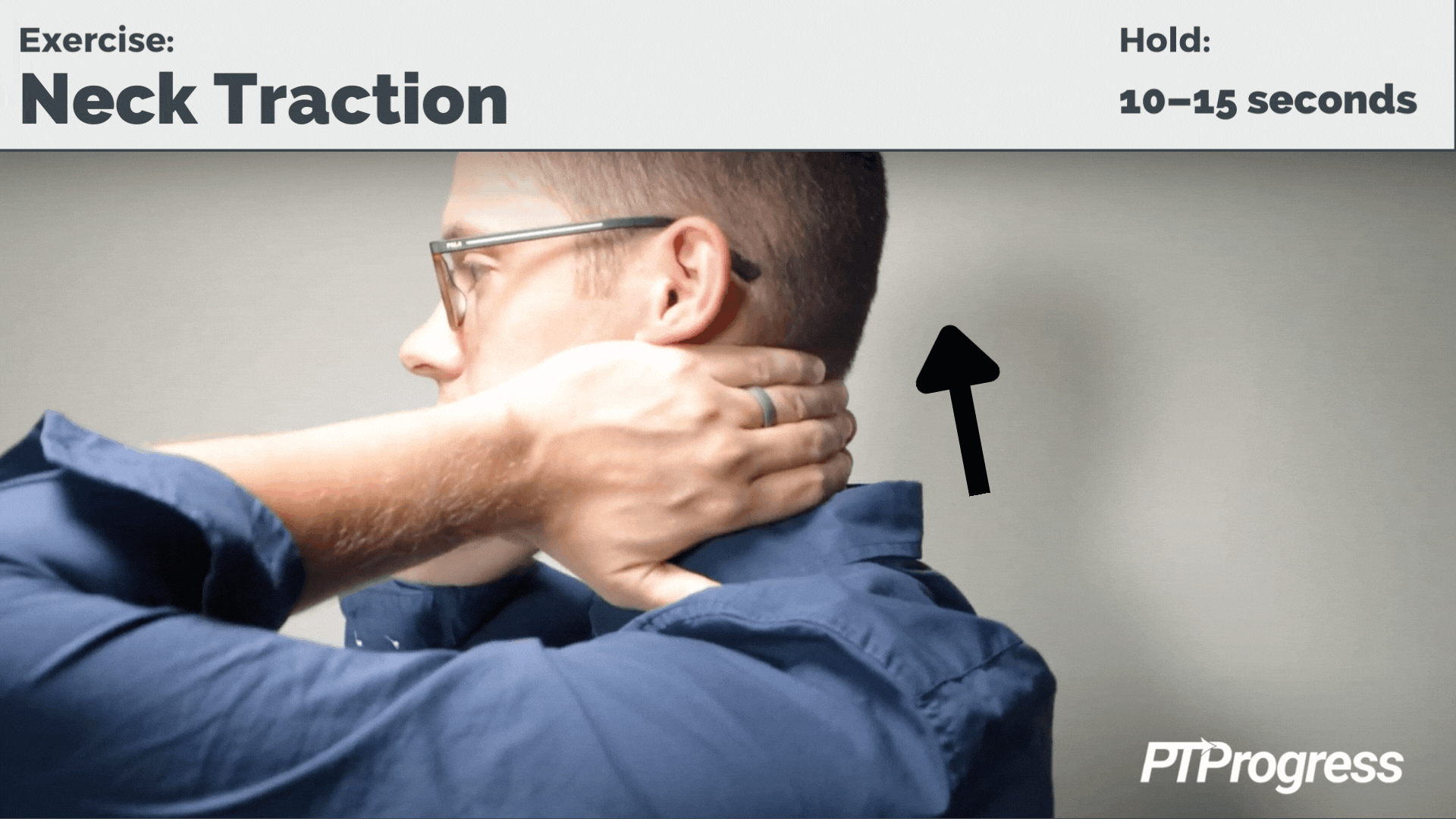
Touch your fingertips together and cuff your hands around the back of your head, with the base of your hands against your jawline. From here, gently pull your neck up towards the ceiling, as if you’re trying to grow taller. With this motion you should start to feel some decompression along your neck. Repeat a few times, holding for 10–15 seconds each time.
Decompression Range of Motion
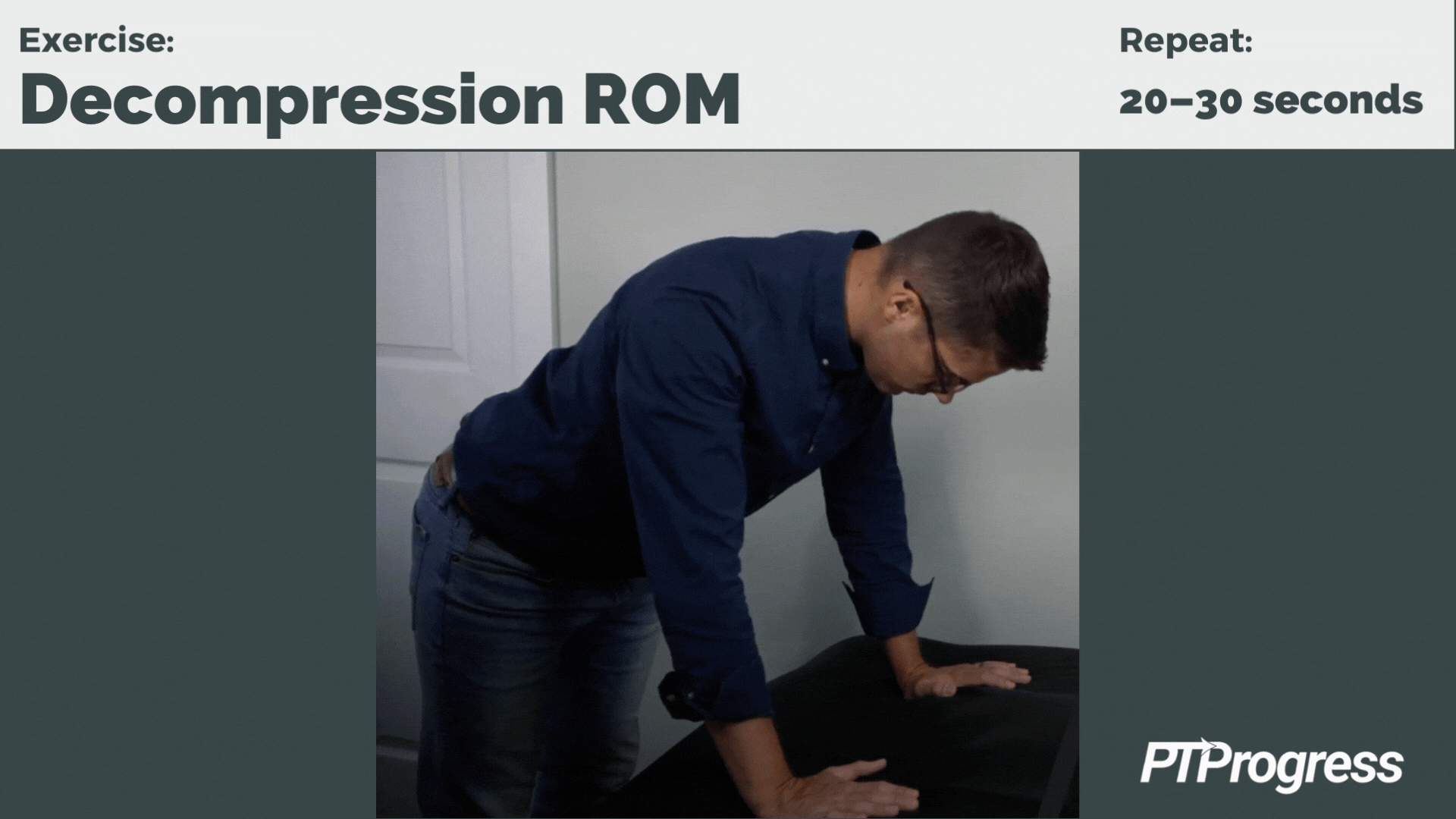
A stiff neck usually means a short range of motion; you can’t turn your head very far without pain. But that stiffness will only worsen without movement. The trick to turning your head without pain is to offload your shoulders of the weight of your arms. Prop each arm on a pillow or place your hands on a countertop so your arms don’t pull on your shoulders. Now you can work on slowly rotating your neck in both directions for 20–30 seconds at a time.
Towel-Assisted Neck Mobilization
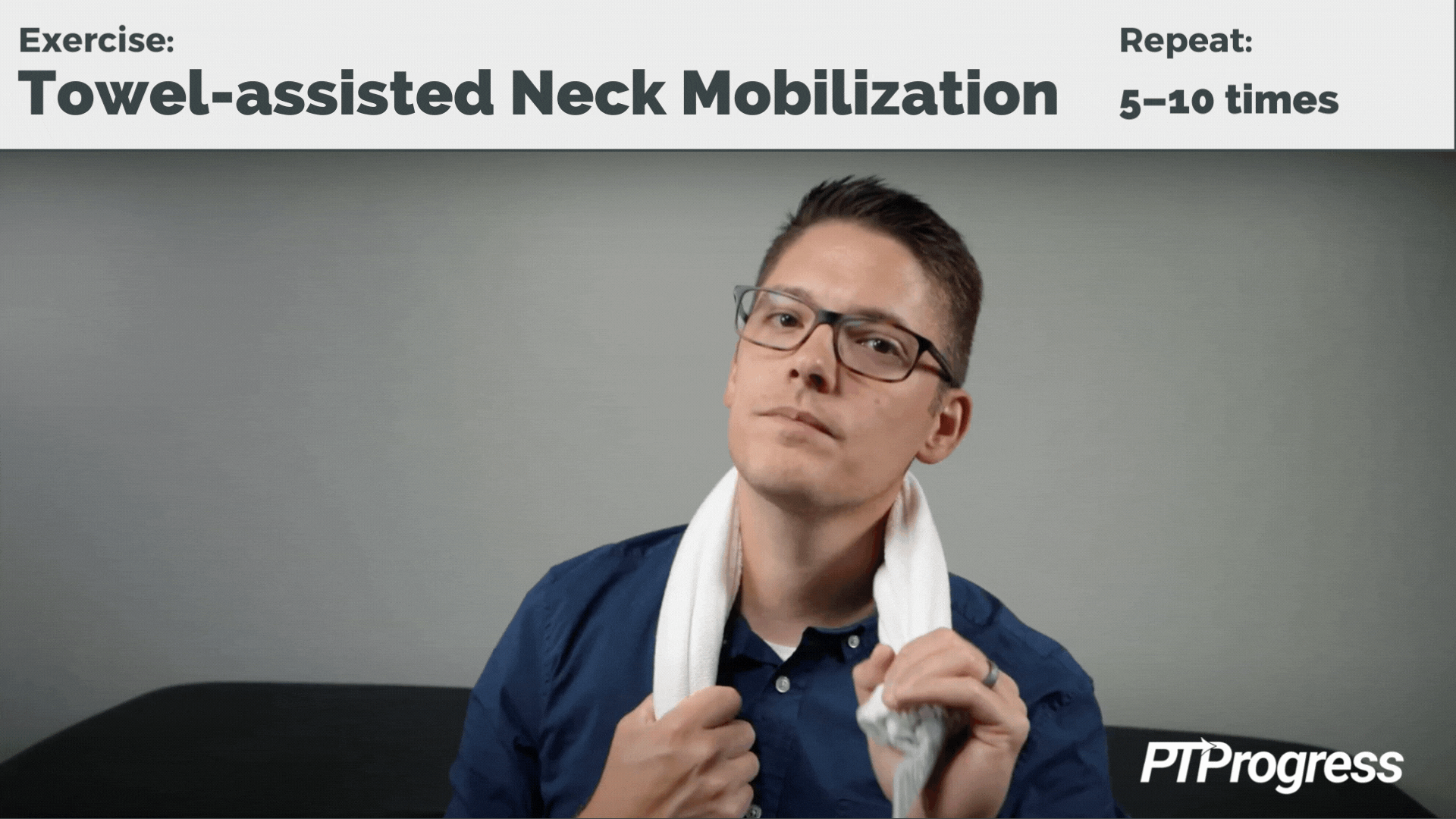
Before showing you a good neck stretch, there’s one more mobilization technique to try. Grab a towel and drape it around your shoulders. You’ll use one end of the towel to stabilize your shoulder and prevent it from tensing up, while the other end of the towel will assist a head turn. So find the spot on your neck that is most sore or stiff—let’s say your right—and hold the towel against your right shoulder with your right hand. With your left hand, guide the other end of the towel across your jawline and turn your head to the right. Repeat 5–10 times, slowly and carefully, then switch sides.
SCM Stretch
Your SCM, or sternocleidomastoid, is the large muscle along the side of your neck that rotates and bends your neck. It’s one of the easiest neck muscles to locate and stretch.
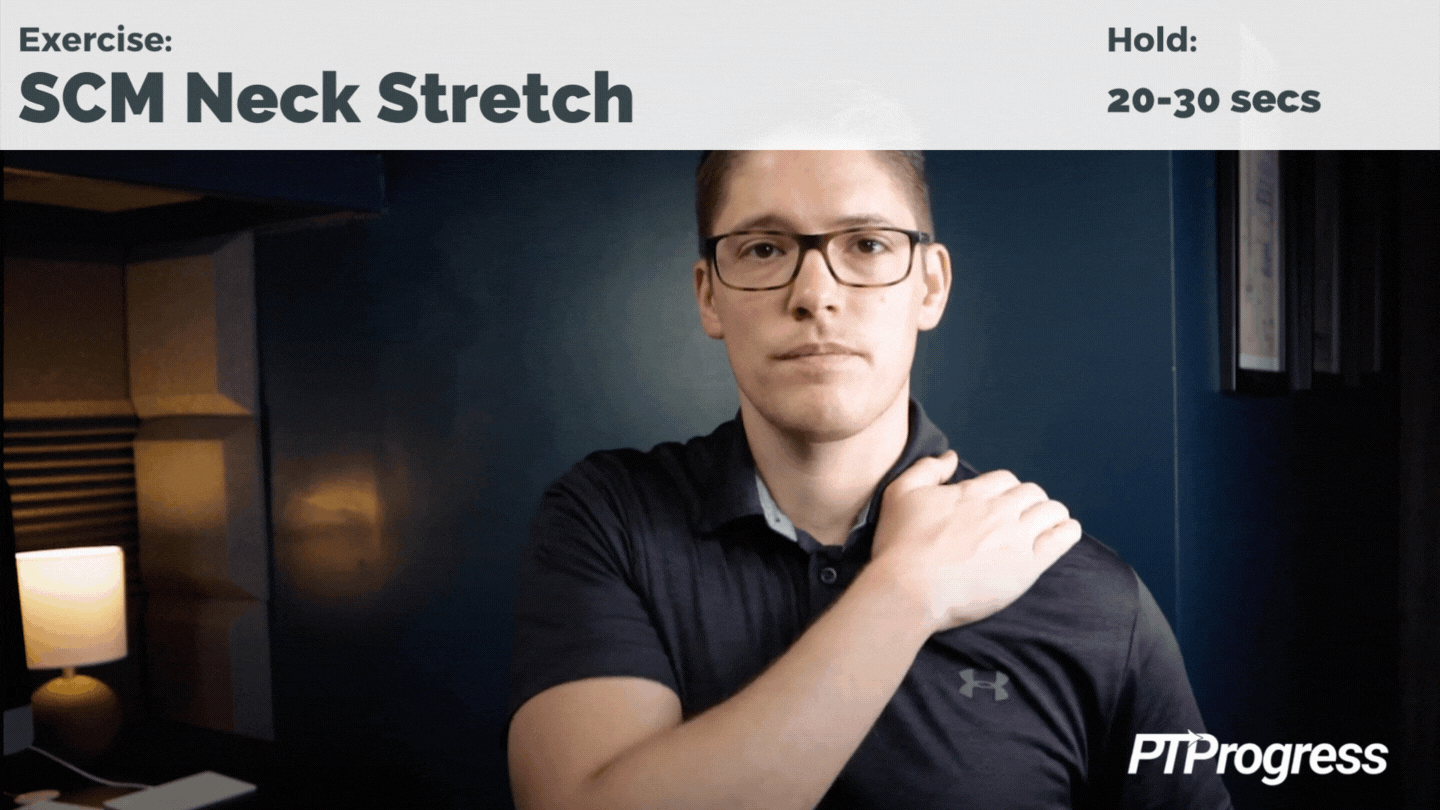
Sit up tall and square your shoulders. Stabilize your right shoulder (or whichever side is more painful) by holding it down with your right hand. Bend your neck so your left ear sinks down towards your left shoulder, moving slowly and gradually within a pain-free range. You should feel a stretch right away, but from here you can deepen it by turning your head slightly to look up at the ceiling. Hold for 30 seconds before returning to center and repeat on the other side.
Final Thoughts
Although neck pain can be a serious inconvenience, there are many ways to safely treat it at home. Always consult a doctor if the pain is severe, persistent, or accompanied by other symptoms such as dizziness or numbness/tingling in your hands.
TENS therapy is one of many methods you can use to mask neck pain as you work on solving the root of the problem. If that problem is poor posture, check out this post for exercises and stretches that will help you straighten up. Alternatively, this post can help you troubleshoot whether your sleeping position is causing pain.


